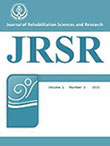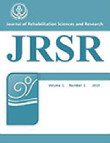فهرست مطالب

Journal of Rehabilitation Sciences and Research
Volume:3 Issue: 2, Jun 2016
- تاریخ انتشار: 1395/06/30
- تعداد عناوین: 5
-
-
Pages 25-28BackgroundPatellar mal tracking is responsible for pain and disability in patellofemoral pain syndrome (PFPS). Patellar kinesio taping may have different effects on short and long term usage. The aim of this study is to compare the effect of short term and long term patellar kinesio taping in patellar position on women with patellofemoral pain syndrome using Magnetic Resonance Imaging (MRI).MethodsThirty women with a mean age of 32.2 ± 6.18 years with one year history of PFPS participated in this study. All participants provided written, informed consent. MRI was taken three times from participants patellofemoral joint: 1) Without taping, 2) Immediately after taping in the first session, 3) After 10 sessions of taping. The effectiveness of the interventions was determined by measuring the patellofemoral congruence angle (PFCA), lateral patellofemoral angle (LPFA), and lateral patellar displacement (LPD) on MRI images.ResultsStatistical analysis showed that utilizing kinesio taping in short time and after 10 sessions, significantly changed PFCA and LPD except for PFCA after 10 sessions. Moreover, taping didnt have any significant effect to alter LPFA.ConclusionIn short term, mechanical effects of kinesio taping influenced the patella position but in long term, neuromuscular effects may be more effective than each one separately to alter patella position.Keywords: Kinesio Taping, Patella Position, MRI, Short Term Effects, Long Term Effects
-
Pages 29-34BackgroundOne of the most common complaints expressed by individuals with hearing-impairment is the difficulty in speech perception in background noise. Different tests have been developed for the evaluation of reduced ability of speech perception in noise, and the Consonant-Vowel in noise test is one of the simplest one regard to speech materials. The goal of the present study was development and determined validity and reliability of the Persian version of the Consonant-Vowel in noise test, among 18 to 25 year old Persian speaking because of the lack of a Persian version of this test.MethodsThis was a tool-making research that had 3 main stages: development of the Persian version of the Consonant-Vowel in noise test (4 lists and each list in 5 different signal to noise ratio), examination of its content validity, and its administration on a total of 50, 18 to 25 year normal hearing individuals (20 men /30 women) that selected by random sampling method, in order to examine the reliability of the test from the students of the University of Social Welfare and Rehabilitation Sciences, Tehran, Iran. For descriptive reports, central tendencies and indices of dispersion were used and for statistics relations; Pearson correlation test, intra-class correlation coefficient (ICC), paired t-test and independent t-test were used.ResultsThe content validity ratio for each item was acceptable (CVR>0.62). The lists number 2, 3, and 4; and also the lists number 1 and 4 in the Consonant-Vowel in noise test, were highly correlated (P0.05) and also mens and womens scores (P>0.05). Participant's performance improved as the SNR increased.ConclusionAccording to the study results, it can be concluded that the Persian version of the Consonant-Vowel in noise test has acceptable content validity and reliability, and can be used in clinical and research works.Keywords: Speech Perception in Noise, Consonant, Vowel in Noise test, Validity, Reliability
-
Pages 35-38BackgroundIn this study we investigated the differences of functional gait and balance measures between patients with chronic stroke with different level of concern about falling.MethodsFifty-four patients with chronic stroke participated in this observational, cross-sectional study. The level of concern relating to falls was assessed by using the Falls Efficacy Scale-International. Thirty-three patients were classified as slightly concerned about falling, while twenty-one patients were highly concerned. Patients performed functional gait and balance tests including Berg Balance Scale, Timed Up & Go test, 10 Meter Walking Test and Functional Gait Assessment. The difference in outcome measures between the two groups was determined by an independent t-test.ResultsAll functional gait and balance tests of patients with high concern about falling were poorer than those for patients with slight concern.ConclusionThe level of concern relating to falls may influence gait and balance performance in individuals with chronic stroke and should be addressed in traditional gait and balance rehabilitation programs.Keywords: Stroke, Balance, Gait, Fear of Falling
-
Pages 39-44BackgroundSustained visual attention is a prerequisite for learning and memory. The early evaluation of attention in childhood is essential for their school and career success in the future. The aim of this study was to design, development and investigation of psychometric properties (content, face and convergent validity and test-retest and internal consistency reliability) of the computer - based sustained visual attention test (SuVAT) for healthy preschool children aged 4-6 with their special needs.MethodsThis study was carried out in two stages: in the first stage computer-based SuVAT in two versions original and parallel were developed. Then the test-retest and internal consistency reliability using intra-class correlation and Cronbach's alpha coefficients respectively were examined; Face validity was calculated through ideas gathering from 10 preschool children and content validity evaluated using CVI and CVR method and convergent validity of SuVAT with CPT was assessed using Pearson correlation.ResultsThe developed test showed a good content and faces validity, and also had excellent test-retest reliability. In addition, the assessment of internal consistency indicated the high internal consistency of the test (Cronbachs alpha = 0.869). SuVAT and CPT test demonstrated a positive correlation upon the convergent validity testing.ConclusionSuVAT with good reliability and validity could be used as an acceptable sustained attention assessment in preschool children.Keywords: Children, Attention, Test, Computer, Based, Reliability, Validity
-
Pages 45-50BackgroundThe goal of the present study was to develop and validate the Persian version of the Acceptable Noise Level (ANL) test in normal, Persian-speaking children aged 5-8 years.MethodsThis tool-making and non-experimental research was conducted in two stages. In the first stage the proper story was selected and recorded after evaluation of its content validity. In the second stage this test material was administered to a total 181 normal children (97 girls and 84 boys) randomly chosen from the population of preschool and primary school children of Tehran (District 5), aged 5-8 years in four age groups to evaluate the reliability of test in order to develop the Persian version of the ANL test and assess its changes during the growth. Lawshes method and Cronbachs alpha coefficient were used to assess the content validity and reliability of the test, respectively. MannWhitney U test was used to examine gender differences, and Kruskal-Wallis test was to examine age differences.ResultsTest-retest correlation of 0.74 indicated acceptable reliability of the test. Significant differences were found between most of different age groups for the ANL mean scores (P0.05).ConclusionThe study results indicated good validity and reliability of the Persian version of the ANL test in children. Therefore this test can be useful in designing classrooms suitable for 5-8 year-old children of both genders.Keywords: Acceptable Noise Level (ANL) Test, Children, Validity, Reliability


